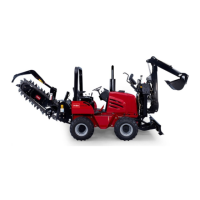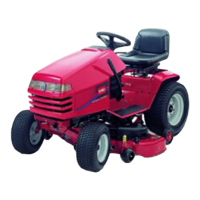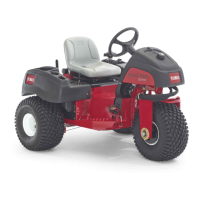Figure76
1.Radiatorcap3.Ventvalve
2.Fillerneck
5.Removetheradiatorcapfromthellerneckofthe
radiatorandcheckthecoolantlevel(Figure76and
Figure77),
Note:Thecoolantshouldbeuptothellerneck.
Figure77
1.Reservoir
3.Coolantlevel(bottomof
radiatorneck)
2.Coolantlevel(halfway
betweentheAddandFull
marks)
4.Radiatorcap
6.Ifthecoolantlevelislow,addcoolantuntilthelevelis
uptothebottomofthellerneck(Figure77).
Important:Donotoverlltheradiator.
Note:Iftheradiatorcoolantlevelislowandthe
coolantreservoirlevelisattheFullmark,checkforair
leaksinthehosebetweentheradiatorandthecoolant
reservoir.
7.Closetheventvalve.
8.Installtheradiatorllercap,ensuringthatitistightly
sealed.
9.Iftheairtemperatureisbelow0°C(32°F),mixthe
ethyleneglycolandwatercompletelybyrunningthe
engineatoperatingtemperaturefor5minutes.
CheckingtheConditionofCooling
SystemComponents
ServiceInterval:Every300hours
Checktheconditionofthecoolingsystemforleaks,damage,
dirt,andloosehoses,andclamps.Clean,repair,tighten,and
replacethecomponentsasnecessary.
CheckingtheConcentrationofthe
Coolant
ServiceInterval:Every1,000hours
Testtheconcentrationofethyleneglycolbasedantifreezein
thecoolant.Ensurethatthecoolantisamixtureof50%
ethyleneglycoland50%water.
Note:Anantifreezehavingamixtureof50%ethylene
glycoland50%waterwillprotecttheengineto-37°C(-34°F)
throughouttheyear.
Checktheconcentrationofthecoolantmixturetoensurethat
itisamixtureof50%ethyleneglycoland50%water.
CleaningtheCoolingSystem
ServiceInterval:Every2,000hours/Every2years
(whichevercomesrst)
DrainingtheCoolantfromtheSystem
Important:Donotpourcoolantontothegroundorinto
anunapprovedcontainerthatcanleak.
1.Removetheleftandrightsidepanelsandthenose
panel;refertoRemovingtheSidePanels(page35)and
RemovingtheNosePanel(page36).
2.Removetheradiatorcap(Figure76andFigure77).
3.Placeadrainpanwithaminimumcapacityof20L(5.3
gallons)undertheopenendofthedrainhose(Figure
78).
Note:Thecoolantcapacityofboththeengineand
theradiatoris17.2L(18.2USqt).
55
